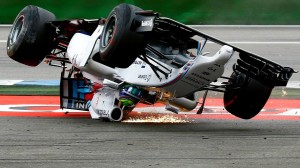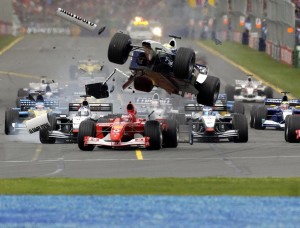How Racing Safety Has Evolved
Former F1 pilot Hans Stuck is credited with one of the most memorable quotes in autodom.
“When I raced a car last,” Stuck proclaims, “it was a time when sex was safe and racing was dangerous, now it’s the other way around.”
Social commentary aside, Stuck is right. The advances made in safety for racing drivers over the last half-century have reduced the sports mortality rate by orders of magnitude, and even allowed drivers to walk away from crashes that at one time would most certainly have been fatal.
Even now, engineers and medical experts work tirelessly to continue to improve the safety record of a sport that is inherently dangerous. Let’s take a look back at how things came so far.
The Early Days of Motoring
Much has been written about the courage of drivers from the golden age. Those who shared the track with names like Fangio and Andretti were known to shun relationships because of the ever-looming presence of death in the sport.
Things improved only slightly in the ‘60s and ‘70s, when the fiery wreck that nearly claimed Ferrari driver Nikki Lauda’s life made clear the importance of fire-retardant suits that previous drivers sometimes chose not to wear. This was perhaps the sports second major safety advance, following the helmet — which needs no explanation.
Still, it was an era when drivers faced a nearly 1-in-20 chance of losing their life during a five-season career. There was still a lot of good left undone.
Higher Speeds and Safer Steeds
With no one in the industry keen on continuing to watch good drivers perish, technology begin to play a larger role in car development. Beginning in the early ‘70s with cars like the famous Ford GT, fuel cell technology reduced the risk of fire in the event of a crash, and more advanced safety harnesses were implemented to keep drivers from being thrown from their cars.
By the 1980s, cars had improved to the point that driving professionally was no longer reserved for the clinically insane. However, there were still many significant advances to be made, as Ayerton Senna’s tragic death at Imola in 1994 revealed.
In the wake of Senna’s passing, the introduction of the head-and-neck restraining HANS device has been credited as one of the most significant advances in motoring safety. The device was implemented across all major forms of racing, including NASCAR and Formula one.
Today’s Impressive Technology Continues to Improve Safety
What has been achieved in the course of 50 years is quite impressive, and yet there is no way to remove the element of danger from racing with certainty. Efforts continue, and have in recent years focused on the use of new, stronger and safer materials, such as Ford’s implementation of Gorilla Glass windshields in the modern-day GT.
In Formula One, the ages-old battle over capping off cockpits — one that has been maligned by promoters who wish to share their drivers with fans — might finally be coming to an end. There are several proposed solutions being tested.
How Safe Is Safe Enough?
Is racing really racing if you remove the element of danger? While it’s uncomfortable to think about, there is certainly some truth in the words of men like Hemmingway, who wax philosophical about the romance of putting one’s life at stake behind the wheel.
As performance continues to increase, new approaches must be developed to keep drivers safe. There is nothing romantic about loss of life, but it is inspiring to see how far we’ve come, and the future promises to deliver even more effective new technologies.











